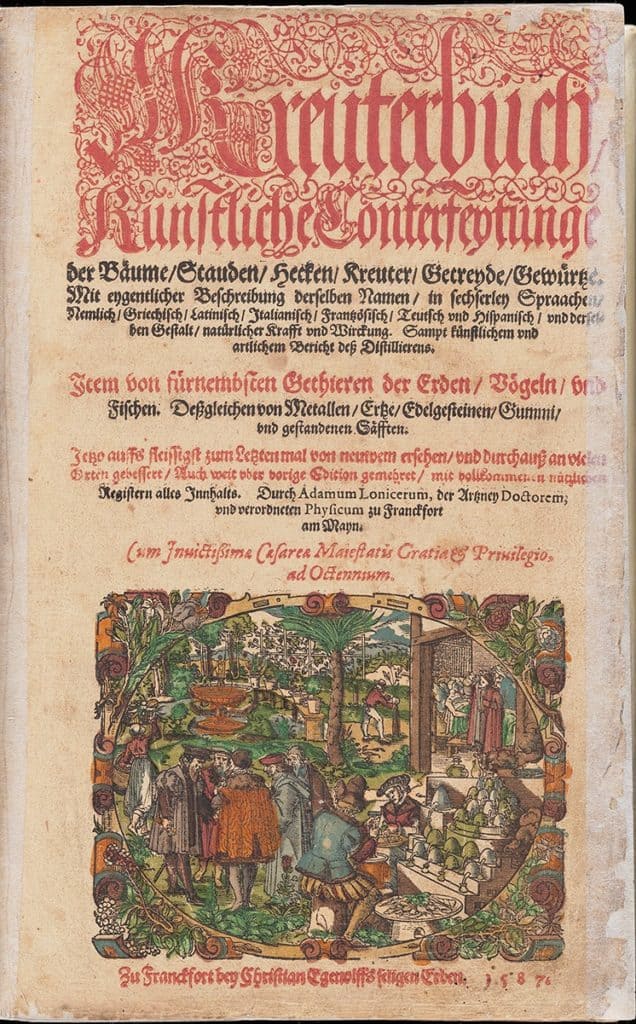by Duncan Stewart, MA, MLIS, Rare Materials Cataloger, University of Iowa Libraries,
Adjunct Faculty, School of Library and Information Sciences, University of Iowa

The John Martin Rare Book Room (JMRBR) is filled with books of great medical historical value. But do you know how all those books get into the JMRBR? A book’s journey to the Rare Book Room may start as a donation or as a purchase from a rare book dealer. After being physically recorded as a new part of the collection, all books travel next to one of the University of Iowa Libraries’ rare book catalogers.
Catalogers ply their trade buried within library technical services departments. There they pore over uncatalogued books, comparing the book in hand to its donor or vendor descriptions, taking note of authors, how the leaves of paper were printed and bound, recording how many pages and illustrations there are, and spotting errors that make that book unique. Then catalog librarians weave these disparate threads of information into a single tapestry in the online catalog enabling scholars and other library patrons to discover a new and unique addition to the collection. A full essay on all aspects of cataloging rare books would be long and probably stupefying. However, this title page from a 16th-century herbal work on medicinal plants illustrates one step of rare book classification.
The full title is:
Kreuterbuch, kunstliche Conterfeytunge der Bäume, Stauden, Hecken, Kreuter, Getreyde, Gewürtze : mit eygentlicher Beschreibung derselben Namen, in sechserley Spraachen, nemlich Griechisch, Latinisch, Italianisch, Frantzösisch, Teutsch und Hispanisch und derselben Gestalt, natürlicher Krafft und Wirkung. Sampt künstlichem und artlichem Bericht des Distillierens. Item von fürnembsten Gethieren der Erden, Vögeln, und Fischen, dessgleichen von Metallen, Ertze, Edelgesteinen, Gummi, und gestandenen Säfften. Jetzo auffs fleissigst zum Letzten mal von neuwem ersehen, und durchauss an vielen Orten gebessert, auch weit über vorige Edition gemehret, mit vollkommenen nützlichert Registeren alles Innhalts / durch Adamum Lonicerum
Or loosely translated into English from 16th-century German:
Herbal book, an artful representation of trees, shrubs, hedges, herbs, grains, and spices. With detailed description and their names in six different languages, Greek, Latin, Italian, French, German, and Spanish, and with descriptions of their physical appearance, natural strength, and effects. Artfully collected into a report on distilling. As well as information about the most important animals of the earth, birds, fish, metals, ores, precious stones, saps, and juices. Now seen in greater detail than the previous edition, greatly improved, with useful tables of contents / by Adam Lonitzer.
The title page does not provide all the information needed, such as the number of pages, printing technique, or binding method, But the lengthy title conveys what the book is about, as well as where, when, and who created it. It also contains a wealth of information to begin an online catalog record. Details like the author’s name, which will be one way to find this book in the catalog. The details in the title help the cataloger determine subject headings to describe the book’s contents. And create a call number. The place, printer, and date at the foot of the title page offer details of book production in the western part of Germany in the late 16th century. The woodcut print demonstrates the intricate carving and laborious hand coloring lavished on illustrations in this text.
 The title page printed in red and black, the luxurious decoration, and the Gothic script all serve notice that this book is one of some importance. Also, the woodcut illustration depicts an image of men at work, especially in the important economic activity of distilling in Frankfurt am Main, which continues to this day. Thus, the title page is the foundation for the catalog record below.
The title page printed in red and black, the luxurious decoration, and the Gothic script all serve notice that this book is one of some importance. Also, the woodcut illustration depicts an image of men at work, especially in the important economic activity of distilling in Frankfurt am Main, which continues to this day. Thus, the title page is the foundation for the catalog record below.
| Title | Kreuterbuch,… |
| Author | Lonicer, Adam 1528-1586 |
| Subjects | Botany — Pre-Linnean works |
| Natural history Botany, Medical — Early works to 1800 | |
| Medicinal plants | |
| Herbals | |
| Herbs | |
| Distillation | |
| Materia medica | |
| Vellum bindings (Binding) | |
| Encyclopedias — Germany — 1587 | |
| Description | Binding: Modern vellum over pasteboard, raised bands, black and red morocco labels |
| First published in Latin under title: Naturalis historiae opus novum. | |
| Foliated with pages numbered on recto | |
| Signatures: )(⁶ 3*⁴ 2*⁴ A-O⁶ P⁴ Q-Z⁶ a-z⁶ 2A-2E⁶ 2F⁴ 2A-2M⁶ 2N⁵ | |
| “Five large and 13 small woodcut vignettes, and hundreds of woodcuts of plants, flowers, fruits, animals, minerals and gems, all with contemporary hand coloring.”–Vender catalog | |
| Title printed in red, guide words throughout | |
| Includes indexes | |
| References: Pritzel (2nd) 5599 | |
| Publisher | Zu Franckfort : Bey Christian Egenolffs seligen Erben |
| Creation Date | 1587 |
| Format | 14 unnumbered pages, CCCLXXXII, 3 unnumbered leaves : color illustrations ; 31 cm |
| Language | German |
| Additional title | Naturalis historiae opus novum |
